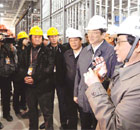Economy
China's novel approach to iron ore negotiations
(Xinhua)
Updated: 2010-05-02 13:40
 |
Large Medium Small |
BEIJING - In response to the world's top three iron ore suppliers' negotiation attitude of "take it or leave it", China can both take it and leave it in different ways, experts say.
"It seems China has accepted the quarterly benchmark iron ore pricing scheme proposed by the iron ore trio," said Zhang Lin, analyst at Langesteel.com, the country's leading steel information service provider, while on the other hand, "it is increasingly finding substitutes for iron ore."
The three giants established the quarterly benchmark pricing scheme at the beginning of this month by reaching a deal with the Japanese steel industry, hiking prices nearly 100 percent.
Luo Bingsheng, vice chairman of the China Steel Association, said Wednesday the association had allowed steelmakers to buy iron ore independently since no agreement has been reached between the association and the trio.
"Although Luo said the association has not given up trying for a more acceptable price based on an annual benchmark pricing system, it has given de facto recognition to the new system with tacit consent," Zhang said.
"The price hike has almost driven Chinese steel mills, who survive on only three percent profit margins, to desperation," said Zhou Xizeng, a senior analyst with CITIC Securities.
The first quarter net profit of 77 large and medium-sized steelmakers in China declined 14.31 percent from the previous quarter.
While the overall profit margin for China's steel industry in the first quarter was just 3.25 percent, lower than the average 6 percent profit margin of the country's industrial sector.
"The price hike will definitely make the Chinese steel industry suffer in the short term. But in a long run, it may do the industry good," Zhou said, adding that it is the same for industries using steel like the auto, home appliances and shipbuilding businesses.
"China must accommodate itself to the quarterly benchmark pricing scheme, and even pricing schemes based on steel indexes," Zhang said.
But more importantly, China should improve the financial market by developing iron ore futures and its own metal index, Zhang added.
The indexes of three major iron ore index providers - the TSI index, MBIO index and Platts index - are based mainly on Chinese demand.
While China, the world's biggest iron ore consumer, does not have its own iron ore index. That was a disadvantage for China during negotiations, because imports accounted for 62.3 percent of China's total iron ore consumption last year, Zhang said.
Besides actively exploiting iron ore mines at home and abroad, China is also making iron and steel from steel scrap.
As a major substitute for iron ore, steel scrap contributed 17 percent of total steel production in 2005, according to data provided by the China Steel Association.
Some downstream industries have even started reducing steel use due to the iron ore price hikes.
"All our products till April next year have been ordered, which is quiet different to the days when we needed to do a lot of marketing," said Cui Zekai, a salesman from No.Seven Wuyue Plastic Plant in Suzhou, in east China's Jiangsu Province. The plant produces auto parts made of plastic.











